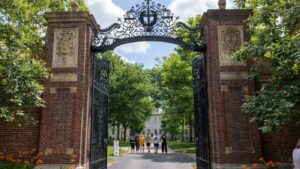Colleges Seek to Enroll Growing Hispanic Student Population Amid Declining Enrollment
As many higher education institutions face declining enrollment, one group of prospective students is becoming increasingly important: Hispanic high school graduates. Colleges are adapting their strategies to attract and support this demographic, which is expected to grow significantly in the coming years.

In River Forest, Illinois, Jacqueline Quintero’s experience highlights a shift. When visiting colleges, she felt out of place until attending an event at Dominican University. The university provided information in both English and Spanish, allowing her parents to engage directly for the first time. “I literally cried,” said Quintero, now a junior aiming for law school.
This bilingual approach is part of a broader effort that has increased Dominican’s enrollment by nearly 25% since 2021, while many similar institutions struggle. The university’s success is attributed to its focus on recruiting Hispanic students, a group historically underrepresented in higher education.
“The demographics in our country are changing, and higher education has to adapt,” said Dominican’s president, Glena Temple.
A Growing Pool of Students
The National Center for Education Statistics reports that nearly one-third of K-12 students are Hispanic, a significant increase from a decade ago. By 2041, the number of Hispanic high school graduates is expected to rise by 16%, while white, Black, and Asian graduates will see declines.
Yet, despite their growing numbers, fewer Hispanic high school graduates are heading straight to college. The rate dropped from 70% in 2012 to 58% in 2022. Colleges previously could ignore this demographic, but as Deborah Santiago of Excelencia in Education noted, “That’s no longer the case.”
Addressing Workforce Needs
The Kansas City metropolitan area’s largest school district is now 58% Hispanic, showcasing the potential for colleges to recruit these students. “It’s what we need to be preparing for,” said Greg Mosier, president of Kansas City Kansas Community College, which now advertises in Spanish.
Experts emphasize that this isn’t just about filling seats; it’s about meeting national economic needs. By 2031, 43% of jobs will require at least a bachelor’s degree, according to the Georgetown University Center on Education and the Workforce. Encouraging more Hispanic students to pursue higher education could alleviate potential labor shortages.
However, challenges remain. Hispanic families typically have lower median incomes, and many students are the first in their families to attend college, complicating access. Additionally, some face pressures to enter the workforce immediately after high school.
Creating Inclusive Environments
Dominican University, with its history of serving immigrant families, has implemented various strategies to welcome Hispanic students. These include bilingual tours, financial aid for all students, and community support services. A new satellite campus in Chicago offers associate degrees in a predominantly Mexican American neighborhood.
Such efforts have more than doubled Hispanic enrollment at Dominican in the past decade. “We address the needs of the students not because of who they are,” said Genaro Balcazar, Dominican’s chief operating officer, “but because they need the help.”
While other universities are beginning to adopt similar strategies, challenges like the dismantling of diversity programs and financial support for undocumented students complicate progress. Experts like Sylvia Hurtado of UCLA stress the importance of culturally responsive recruitment efforts.
“Having students succeed is in everybody’s interest,” said Anne-Marie Núñez from the University of Texas at El Paso. “The country will get left behind if it doesn’t have all hands on deck.”
This story was produced by The Hechinger Report, a nonprofit, independent news organization focused on inequality and innovation in education.






